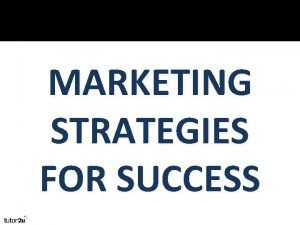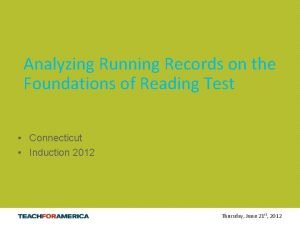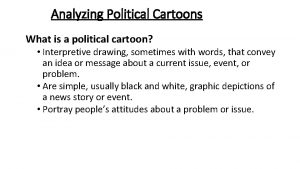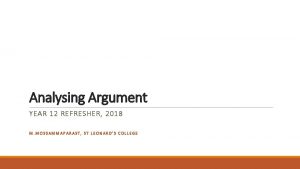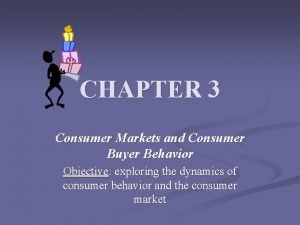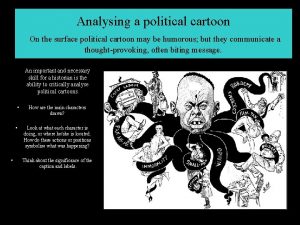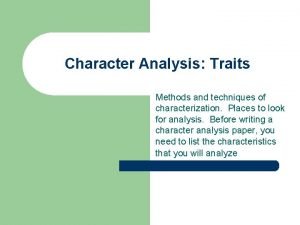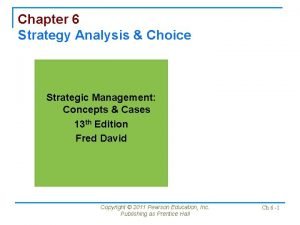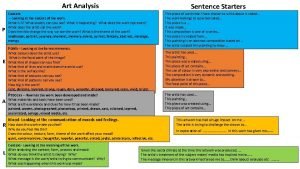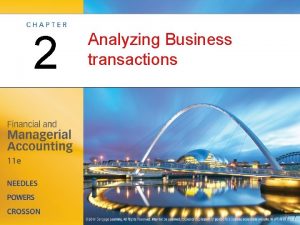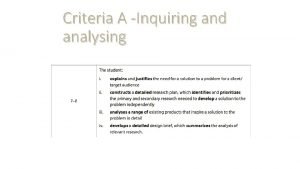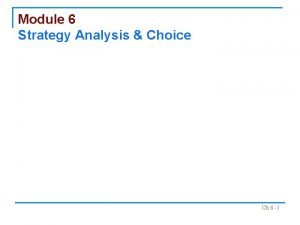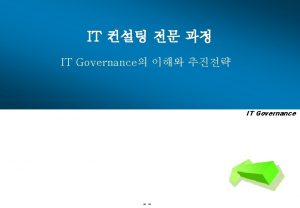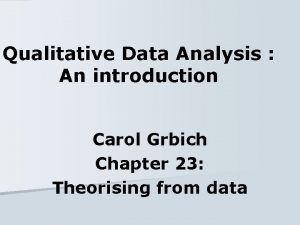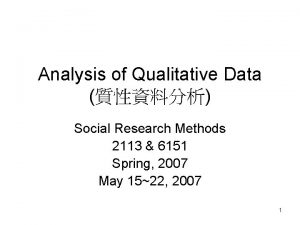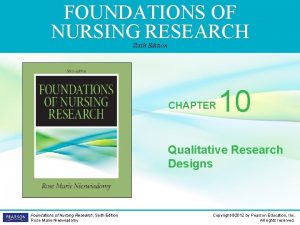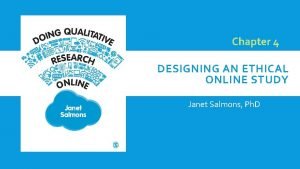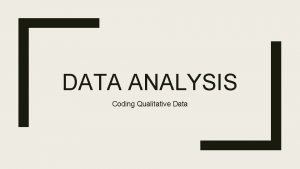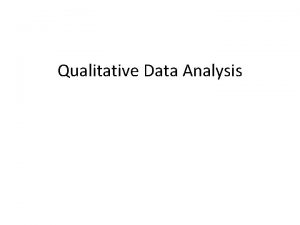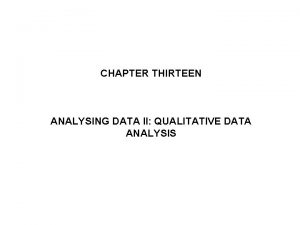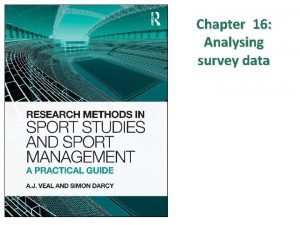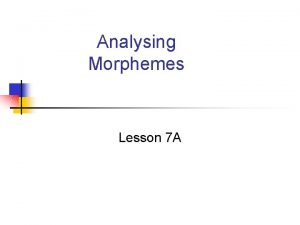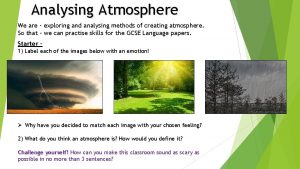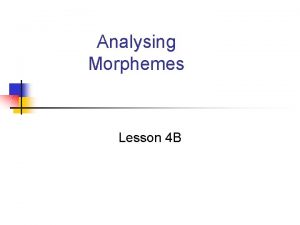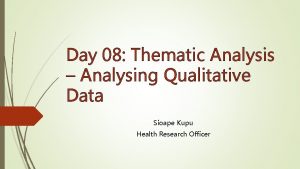Chapter 15 Analysing qualitative data CONTENTS Introduction Data


























- Slides: 26

Chapter 15: Analysing qualitative data

CONTENTS • • • Introduction: Data collection, analysis, storage Case study example Manual methods Qualitative analysis using computer software NVivo

Qualitative data collection and analysis (Fig. 15. 1) Traditional deductive/ quantitative model C. Analysis B. Observation/ description Data collection A. START: Explanation/ hypotheses/ theory/ research questions The literature and informal observation A. J. Veal & S. Darcy (2014) Research Methods for Sport Studies and Sport Management: A practical guide. London: Routledge

On-going Data collection Qualitative data collection/analysis contd Inductive/ qualitative model D. Refinement of hypotheses/ research questions C. Analysis B. Observation/ description Data collection E. Continuing observation/ description F. Final analysis A. START: Explanation/ hypotheses/ theory/research questions The literature and informal observation A. J. Veal & S. Darcy (2014) Research Methods for Sport Studies and Sport Management: A practical guide. London: Routledge

Data storage and confidentiality • As discussed in Ch. 4: Research ethics • Problems when respondents names A. J. Veal & S. Darcy (2014) Research Methods for Sport Studies and Sport Management: A practical guide. London: Routledge

Case study example: CS 15. 1 • Activity choice qualitative study: used to illustrate analysis methods • A conceptual framework diagram: Fig. 15. 2 • Three interview transcripts: Mark, Donna and Lee – copies available on-line A. J. Veal & S. Darcy (2014) Research Methods for Sport Studies and Sport Management: A practical guide. London: Routledge

Outline conceptual framework (Fig. 15. 2): Leisure/sport activity choice affected by a variety of factors Level 1 Level 2 Influences Main activity type Sporting Social Cultural Constraints/ opportunities Personal factors Events A. J. Veal & S. Darcy (2014) Research Methods for Sport Studies and Sport Management: A practical guide. London: Routledge

Case study transcripts: example (Fig. 15. 3) Mark (Age 22, Male, Student, Income £ 8 K) Q. What would you say is your most time-consuming leisure activity outside of the home at present? Well, I would say it's playing football, at least during the season. While the football's on, because of training twice a week and needing to be fairly serious about keeping fit I don't do much else: I probably only go to a pub once - or at most twice - a week. I don't have the time or the money to do much more. Q. How were you introduced to football? Oh, I've always played. . . since I could run around I suppose. My dad says he spotted my talent - so-called - when I was a toddler, but it was one of the teachers at primary school that really encouraged me. He persuaded my mum to take me to a coaching clinic when I was about 8 or 9, then I got into the local under-11 s. A. J. Veal & S. Darcy (2014) Research Methods for Sport Studies and Sport Management: A practical guide. London: Routledge

CS transcript: example: with manual coding (Fig. 15. 3) Mark (Age 22, Male, Student, Income £ 8 K) Q. What would you say is your most time-consuming CODING leisure activity outside of the home at present? Act. : Sport - football Well, I would say it's playing football, at least during the Constraint: season. While the football's on, because of training twice a Commitments, Need to week and needing to be fairly serious about keeping fit I keep fit, don't do much else: I probably only go to a pub once - or at Time, Money most twice - a week. I don't have the time or the money to do much more. Q. How were you introduced to football? Oh, I've always played. . . since I could run around I suppose. Influence: Parent+ My dad says he spotted my talent - so-called - when I was a Teacher ++ toddler, but it was one of the teachers at primary school that really encouraged me. He persuaded my mum to take Event: Coaching clinic me to a coaching clinic when I was about 8 or 9, then I got into the local under-11 s. A. J. Veal & S. Darcy (2014) Research Methods for Sport Studies and Sport Management: A practical guide. London: Routledge

Manual analysis • Importance of reading/re-reading transcripts. • Identification of emergent themes (similar to variables in quantitative research). • Themes may – arise from conceptual framework/ research questions therefore searched for deductively, or – emerge unprompted, inductively. • Themes ‘flagged’ by researcher – as in column 1 of Fig. 15. 3 • Can result in a more developed conceptual frame-work – see Fig. 15. 4 A. J. Veal & S. Darcy (2014) Research Methods for Sport Studies and Sport Management: A practical guide. London: Routledge

Developed conceptual framework (Fig. 15. 4): Leisure/sport activity choice affected by a variety of factors Level 1 Main activity type Sporting Social Cultural Level 2 Level 3 Influences Parents Teachers Peers Constraints/ opportunities Time Money Fitness Personal factors Events Competitiveness Sociability Routine Instrumentality Coaching etc. Weight-gain Relationships Job/money A. J. Veal & S. Darcy (2014) Research Methods for Sport Studies and Sport Management: A practical guide. London: Routledge

Manual analysis: mechanics • Flagging of transcripts (as in Fig. 15. 3) – – In margins Use of colour coding ‘Post-it’ notes Cards • Cataloguing, eg. – Constraint - time: – – Constraint - money: Mark: p. 2, para. 3, Anna: p. 7 para. 4 Mark; p. 2, para. 3 • Searching/flagging/cataloguing can be aided using Wordprocessor ‘search’ facility A. J. Veal & S. Darcy (2014) Research Methods for Sport Studies and Sport Management: A practical guide. London: Routledge

Analysis • Numbers not important • Emphasis on differences rather than similarities • Some analysis parallel to quantitative analysis – eg. Crosstabulation – see Fig. 15. 5 A. J. Veal & S. Darcy (2014) Research Methods for Sport Studies and Sport Management: A practical guide. London: Routledge

‘Crosstabulation’ of qualitative data (Fig. 15. 5) A. J. Veal & S. Darcy (2014) Research Methods for Sport Studies and Sport Management: A practical guide. London: Routledge

Qualitative analysis using computer software • Use of computer-aided qualitative data analysis software (CAQDAS) • Used here: Nvivo (Version 8) – package from QSR (Qualitative Solutions and Research Pty Ltd) – includes N 6 (updated version of the well-known NUD*IST), and XSight for market researchers – see www. qsrinternational. com • Nvivo is used because it is effective and is one of the most well-known packages: use in this book does not imply endorsement of it as the ‘best available’. A. J. Veal & S. Darcy (2014) Research Methods for Sport Studies and Sport Management: A practical guide. London: Routledge

Nvivo procedures covered (Fig. 15. 6) Design coding system Create project Import documents Cases and attributes Modelling Code documents Analysis Link cases and documents Specify attributes A. J. Veal & S. Darcy (2014) Research Methods for Sport Studies and Sport Management: A practical guide. London: Routledge

Nvivo terminology In the Activity Choice study: Cases = the three interviewees: Mark, Donna, Lee Attributes = age, gender, economic status, income Documents = the interview transcripts Importing documents Coding system = specifying of concepts as in a conceptual framework, as in Fig. 15. 4 • Project = a named (Activity. Choice) set of interlinked files, containing details of cases, attributes, coding systems and documents related to a research project • Modelling = diagrammatic presentation of conceptual framework, as in Fig. 15. 4 • • • A. J. Veal & S. Darcy (2014) Research Methods for Sport Studies and Sport Management: A practical guide. London: Routledge

Note to teachers • The best approach from here on is to ‘go live’ with NVivo with the example data pre-loaded onto your computer and follow the procedures in the book. • If this is not possible and you wish to proceed to provide an overview using Power. Point, the Figures from the book are included in the following slides. A. J. Veal & S. Darcy (2014) Research Methods for Sport Studies and Sport Management: A practical guide. London: Routledge

Screen for Figure 15. 7 Create Nvivo project

Screen for Figure 15. 9 Cases and attributes

Figure 15. 10 Importing internal documents Figure 15. 11 Linking documents and cases

Screen for Figure 15. 12 Coding system

Screen for Figure 15. 13 Modelling

Screen for Figure 15. 14 Coding text

Fig 15. 15 Activity Choice project summary Analysis Cases: Mark Lee Donna Attributes: Age Gender Income Empl. status Inteviews: Mark. doc Lee. doc Donna. doc Coding system: Main activity: Activity type Personal Constraints Events Influence

Screen for Figure 15. 16 Coding query
 Analysing market data
Analysing market data Analysing running records
Analysing running records Analogy political cartoon
Analogy political cartoon Analysing argument
Analysing argument The buying process starts when the buyer recognizes a
The buying process starts when the buyer recognizes a The prohibited chow pest
The prohibited chow pest Methods of analysis character
Methods of analysis character Analysing the 6 strategic options megxit
Analysing the 6 strategic options megxit Analyze sentence starters
Analyze sentence starters Analysing business transactions
Analysing business transactions Inquiring and analysing
Inquiring and analysing Strategic analysis and choice in strategic management
Strategic analysis and choice in strategic management Analysing argument
Analysing argument Analysing the 6 strategic options megxit
Analysing the 6 strategic options megxit Contents introduction
Contents introduction Characteristics qualitative research
Characteristics qualitative research Chapter 10 qualitative data analysis
Chapter 10 qualitative data analysis Quantitative data vs qualitative data comparison
Quantitative data vs qualitative data comparison Data
Data Qualitative paper example
Qualitative paper example Qualitative research designs chapter 10
Qualitative research designs chapter 10 Chapter 3 research methodology sample qualitative
Chapter 3 research methodology sample qualitative Chapter 5 qualitative research example
Chapter 5 qualitative research example Ethical issues in qualitative research chapter 4
Ethical issues in qualitative research chapter 4 Qualitative data geography
Qualitative data geography Narrative report with contextual description
Narrative report with contextual description Example of qualitative data
Example of qualitative data
